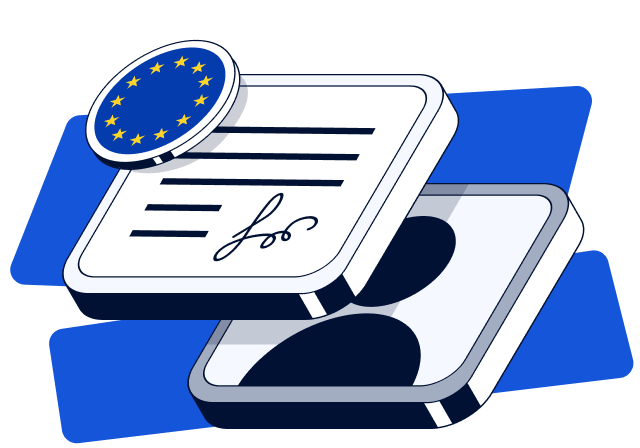- Jul 11, 2025
- 3 min read
Breaking News, Explained: eIDAS Summit Explores European Digital Identity
Explore key takeaways from the eIDAS 2025 Summit, how digital identity is changing in the EU, and what it means for businesses.

The eIDAS 2025 Summit, held in Berlin on June 25, 2025, gathered institutions, national authorities, and digital identity stakeholders from the EU and beyond to assess the electronic IDentification, Authentication and trust Services (eIDAS) Regulation and eIDAS 2.0—the EU’s revised regulatory framework for digital identities and trust services.
Hosted by Bitkom, the German IT industry association, key topics included trust services, the practicalities of the European Digital Identity Wallet (EUDI Wallet), updates on technical frameworks, and use cases. Overall, the summit indicated gathering momentum ahead of the 2026 deadline for EUDI Wallet rollout, while addressing technical, legal, and operational challenges that still need resolution.
Understanding eIDAS, eIDAS 2.0, and their impacts
Originally adopted in 2014, the eIDAS Regulation (No 910/2014) established a legal framework for cross-border electronic identification and trust services across the EU. Its core goal is to enable seamless, cross-border digital transactions by ensuring electronic identities, signatures, seals, and other trust services are recognized and interoperable throughout the EU.
eIDAS promotes mutual recognition of national eID schemes, allowing citizens and businesses to use their home country’s digital identity to access public and private services in any other EU country—thus reducing administrative burdens and increasing trust in digital services.
The eIDAS 2.0 update (No 2024/1183) lays the groundwork for European Digital Identity and aims to give EU citizens more control over their personal digital data via the EUDI Wallet. This would limit the data third parties receive in exchanges, thus improving data protection.
Understanding eIDAS 2.0 and complying with it is essential for businesses operating in EU member states, particularly those in regulated sectors. It streamlines electronic identification trust services in a way that reflects the evolving digital transaction and identity landscape.
Suggested read: Digital Identity in 2025: The Complete Guide
eIDAS 2.0: What’s changing?
eIDAS 2.0 lays the groundwork for European Digital Identity, with a core update being the introduction of the EUDI Wallet. This is a mobile-based wallet, controlled by the user, that allows EU citizens and businesses to securely store and share verified identity data, including name, date of birth, and bank account details.
Private-sector platforms classified as Very Large Online Platforms (VLOPs), such as banks, will be required to accept the wallet as soon as technically feasible. However, conferences like the eIDAS 2025 Summit show that how this will actually work is still being refined. Nevertheless, affected parties must prepare for regulatory compliance, interoperability, high levels of security, and mechanisms for data sharing with real-time consent.
Implications for businesses
For companies operating in transport, energy, banking, financial services, social security, health, drinking water, postal services, digital infrastructure, education, or telecommunications, eIDAS 2.0 introduces compliance responsibilities.
Firms must be ready to accept digital credentials via the EUDI Wallet, meet EU-defined levels of assurance, and ensure their systems align with the latest Implementing Acts. Delays in adoption could lead to non-compliance penalties, loss of customer trust, and increased exposure to identity fraud.
Key challenges and implementation complexities
While eIDAS 2.0 has been in force since 2024, its full implementation is not expected until the end of 2026. When it is fully implemented, it is likely to drastically reform user and business experience, with a single digital identity recognized across the EU, allowing for secure and frictionless verification in everything from opening a bank account to applying for a rental agreement.
Nevertheless, eIDAS 2.0 naturally faces complications in its rollout. Businesses face challenges in technical integration, uncertainty about regulatory compliance, and questions around liability in cross-border scenarios. EU member states are also progressing at different rates, which could lead to a fragmented framework.
According to Biometric Update, digital ID and payments service providers are facing difficulties interpreting obligations under eIDAS 2.0, with the Dutch Payments Association having recently published guidance to help clarify ambiguities for payment service providers.
On June 23, 2025, the European Commission also published a new batch of Implementing Acts related to the EUDI Wallet for public feedback. These acts aim to define technical specifications and formats relating to trusted lists, rules for harmonized accreditation of conformity assessment bodies, and risk management procedures for non-qualified trust service providers.
The EUDI Wallet will incorporate Qualified Electronic Signature (QES) capabilities, allowing users to sign legally binding documents remotely and engage in cross-border and fully digital interactions with ease.
How Sumsub can help
As complex EU-wide regulatory burdens develop to protect sensitive information, businesses need trusted partners to navigate change. Sumsub is an EU-compliant QES Provider, offering binding cross-border digital signatures that meet stringent eIDAS assurance levels.
Sumsub's QES Verification is an onboarding solution that meets the highest eIDAS identification standards and is recognized as a compliant method for user verification under the national AML/CTF requirements in all 27 EU member states as well as Iceland, Liechtenstein, and Norway. The solution also facilitates remote high-value and high-risk document signing with the legal power of a handwritten signature.
With eIDAS 2.0 fast approaching full implementation, our solution is built for the future of digital identity in Europe and helps businesses stay compliant while enhancing trust and user experience.
Relevant articles
What is Sumsub anyway?
Not everyone loves compliance—but we do. Sumsub helps businesses verify users, prevent fraud, and meet regulatory requirements anywhere in the world, without compromises. From neobanks to mobility apps, we make sure honest users get in, and bad actors stay out.





